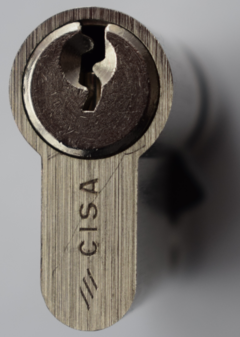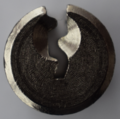CISA C2000: Difference between revisions
mNo edit summary |
m (clean-up) |
||
| Line 9: | Line 9: | ||
| patent = | | patent = | ||
| years_produced = | | years_produced = | ||
| related = | | ratings = [[EN_1303 |EN 1305:2005]] | ||
| spec_on = | | related = [[CISA C3000]] | ||
| spec_comptype = | | spec_on = true | ||
| spec_comp = | | spec_comptype = [[Pin_tumbler|Pin-tumbler]] | ||
| spec_comp = 5 | |||
}} | }} | ||
The '''C2000''' is a [[pin-tumbler]] lock made by [[CISA]]. CISA recommends them for securing the secondary accesses to residential buildings, shops and offices. | The '''C2000''' is a [[EN 1303 |EN 1303:2005]]-rated [[Pin_tumbler |pin-tumbler]] lock made by [[CISA]]. CISA recommends them for securing the secondary accesses to residential buildings, shops and offices. Keys for the C2000 are free to copy. One key pin and one driver pin made of steel provide some drill protection but unfortunately there is no protection against dynamic methods. The [[CISA C3000]] is an improved version of the C2000. | ||
__TOC__ | __TOC__ | ||
| Line 22: | Line 23: | ||
== Principles of operation == | == Principles of operation == | ||
:''See also: [[ | :''See also: [[Pin_tumbler#Principles_of_operation|Pin-Tumbler (Principles of operation)]]'' | ||
The | The C2000 contains five pin-tumbler pairs. One pin chamber contains a standard driver, two have [[Security_pin |spools]], and two have standard drivers with a single wide serration on both ends. Although the C2000 appears quite precisely manufactured, the shear-line was ground, which lowers the amount of anti-picking protection this lock offers. | ||
The keyway is not particularly restrictive, although the curve in the lower right side of it makes counter-clockwise tensioning quite unstable due to the tensioner slippage. | The C2000 has a paracentric keyway. The keyway is not particularly restrictive, although the curve in the lower right side of it makes counter-clockwise tensioning quite unstable due to the tensioner slippage. | ||
== Disassembly instructions == | == Disassembly instructions == | ||
To disassemble a double euro cylinder, use of a pinning shoe is the preferred method. | To disassemble a double euro cylinder, use of a pinning shoe is the preferred method. | ||
Other possibility is to use a segmented follower, but that requires that both cores are pulled out a bit to allow a cam removal. Then a core should be rotated to approximately 4:30 or 7:30 o'clock position (135 degrees either clockwise or anti-clockwise) to prevent driver entering a gaps for the cam clutch. Then a segmented follower can be used to remove the core. | Other possibility is to use a [[Plug_follower |segmented follower]], but that requires that both cores are pulled out a bit to allow a cam removal. Then a core should be rotated to approximately 4:30 or 7:30 o'clock position (135 degrees either clockwise or anti-clockwise) to prevent driver entering a gaps for the cam clutch. Then a segmented follower can be used to remove the core. | ||
== Vulnerabilities == | == Vulnerabilities == | ||
| Line 43: | Line 44: | ||
== Gallery == | == Gallery == | ||
<div align="center"><gallery> | <div align="center"><gallery> | ||
File:C2000 key least.png|CISA C2000 | File:C2000 key least.png |A key for a CISA C2000 cylinder. | ||
File:C2000 keyway least.png|CISA C2000 keyway detail. | File:C2000 keyway least.png |CISA C2000 keyway detail. | ||
File:C2000 pins least.png|CISA C2000 pins detail. The | File:C2000 pins least.png |CISA C2000 pins detail. The malformed springs in first two chambers were present in this condition in the lock when it was bought. | ||
File:C2000 shearline least.png|CISA C2000 shearline detail. | File:C2000 shearline least.png |CISA C2000 shearline detail. | ||
</gallery></div> | </gallery></div> | ||
| Line 58: | Line 59: | ||
* [https://www.cisa.com/en/prodotti/cilindri/C_2000.html CISA C2000 product page] | * [https://www.cisa.com/en/prodotti/cilindri/C_2000.html CISA C2000 product page] | ||
[[Category:Lock models]] | |||
[[Category:CISA]] | [[Category:CISA]] | ||
[[Category:Pin-tumbler locks]] | [[Category:Pin-tumbler locks]] | ||
[[Category:Paracentric keyways]] | |||
[[Category:EN 1303 locks]] | |||
Latest revision as of 12:21, 25 December 2022
CISA C2000
| CISA C2000 | |
 | |
| Name | CISA C2000 |
|---|---|
| Manufacturer | CISA |
| Lock Type | Cylinder |
| Lock Design | Pin-tumbler |
| Security Rating(s) | EN 1305:2005 |
| Specifications | |
| # of Components | 5 |
| Component Type | Pin-tumbler |
| Related Locks | |
| CISA C3000 | |
The C2000 is a EN 1303:2005-rated pin-tumbler lock made by CISA. CISA recommends them for securing the secondary accesses to residential buildings, shops and offices. Keys for the C2000 are free to copy. One key pin and one driver pin made of steel provide some drill protection but unfortunately there is no protection against dynamic methods. The CISA C3000 is an improved version of the C2000.
Principles of operation
- See also: Pin-Tumbler (Principles of operation)
The C2000 contains five pin-tumbler pairs. One pin chamber contains a standard driver, two have spools, and two have standard drivers with a single wide serration on both ends. Although the C2000 appears quite precisely manufactured, the shear-line was ground, which lowers the amount of anti-picking protection this lock offers. The C2000 has a paracentric keyway. The keyway is not particularly restrictive, although the curve in the lower right side of it makes counter-clockwise tensioning quite unstable due to the tensioner slippage.
Disassembly instructions
To disassemble a double euro cylinder, use of a pinning shoe is the preferred method.
Other possibility is to use a segmented follower, but that requires that both cores are pulled out a bit to allow a cam removal. Then a core should be rotated to approximately 4:30 or 7:30 o'clock position (135 degrees either clockwise or anti-clockwise) to prevent driver entering a gaps for the cam clutch. Then a segmented follower can be used to remove the core.
Vulnerabilities
The CISA C2000 is vulnerable to one or more of the following:
Gallery
References



